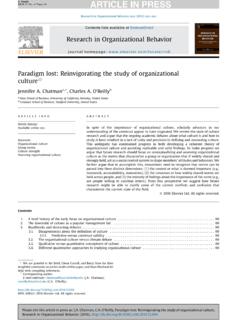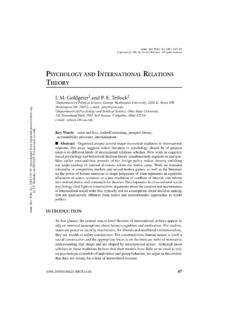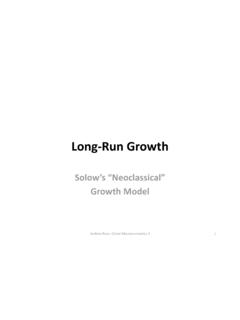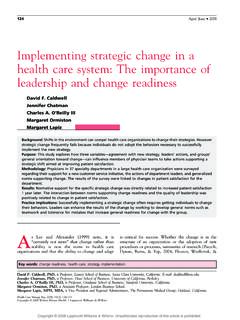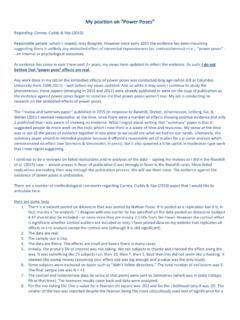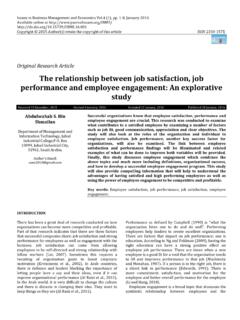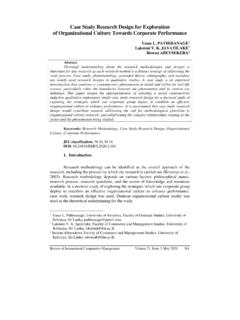Transcription of People and Organizational Culture: A Profile Comparison ...
1 T Academy of Management Journal 1991, Vol. 34, No. 3, 487-516. People AND Organizational culture : A Profile Comparison APPROACH TO. ASSESSING PERSON-ORGANIZATION FIT. CHARLES A. O'REILLY III. University of California, Berkeley JENNIFER CHATMAN. Northwestern University DAVID F. CALDWELL. Santa Clara University This article brings together three current themes in Organizational be- havior: (1) a renewed interest in assessing person-situation interac- tional constructs, (2) the quantitative assessment of Organizational cul- ture, and (3) the application of "Q-sort," or template-matching, ap- proaches to assessing person-situation interactions.
2 Using longitudinal data from accountants and students and cross-sectional data from employees of government agencies and public accounting firms, we developed and validated an instrument for assessing person- organization fit, the Organizational culture Profile (OCP). Results sug- gest that the dimensionality of individual preferences for organiza- tional cultures and the existence of these cultures are interpretable. Further, person-organization fit predicts job satisfaction and organiza- tional commitment a year after fit was measured and actual turnover after two years. This evidence attests to the importance of understand- ing the fit between individuals' preferences and Organizational cul- tures.
3 The notion of Organizational culture has been important in the study of Organizational behavior for the past decade ( , Barley, Meyer, & Gash, 1988; O'Reilly, 1989; Smircich, 1983). In spite of disagreements over some elements of definition and measurement, researchers seem to agree that cul- ture may be an important factor in determining how well an individual fits an Organizational context ( , Kilmann, Saxton, & Serpa, 1986; Schein, 1985). Implicit in writing on this theme is a logic of person- culture fit fun- damentally drawn from an interactional psychology perspective in which aspects of both individual and situation combine to influence a focal indi- vidual's response to a given situation ( , Chatman, 1989; Schneider, 1987.)
4 Terborg, 1981). In this regard, aspects of individuals, such as values and The authors gratefully acknowledge the research support of the Institute of Industrial Re- lations and the Institute for Personality Assessment and Research at the University of California, Berkeley. We also thank John Sheridan and Blair Sheppard for providing data access. 487. 488 Academy of Management Journal September expectations, interact with facets of situations, such as incentive systems and norms, to affect the individuals' attitudinal and behavioral responses. As with similar fit theories of careers (Holland, 1985), job choice (Hackman & Oldham, 1980), work adjustment (Lofquist & Dawis, 1969), and organiza- tional climate (Joyce & Slocum, 1984), the validation of the construct of person- culture fit rests on the ability to assess relevant aspects of both person and culture .
5 This measurement problem is a significant and sometimes con- troversial issue (Keon, Latack, & Wanous, 1982; Rousseau, 1990)-one that is at the center of the person-situation debate, that is, the controversy over the degree to which personality or context variables explain attitudes and behavior (Bem & Allen, 1974; Davis-Blake & Pfeffer, 1989; Kenrick & Funder, 1988). The purpose of this research was to examine person- culture fit and its implications for work attitudes and behavior. We draw on recent develop- ments in the applications of Q-sort, or template-matching,1 approaches to resolve some of the measurement issues that have hindered previous re- search on fit (Bem & Funder, 1978; Block, Block, & Morrison, 1981; Caldwell & O'Reilly, 1990).
6 THEORETICAL BACKGROUND. Person-Situation Fit The general notion of fit, or congruence, has long been important in psychology and Organizational behavior (Nadler & Tushman, 1980). In studying person-situation fit, Organizational behavior researchers have typ- ically taken one of two broad paths. One has led to exploration of the inter- action of individual characteristics and broad occupational attributes, the other to exploration of the fit between specific characteristics of an organi- zation and the People in it. Examples of the second approach range from studying the match of individual skills to job requirements to studying the relationship between individual characteristics and Organizational climate ( , Downey, Hellriegel, & Slocum, 1975).
7 For example, the two major theo- ries of vocational choice (Holland, 1985; Super, 1957) both postulate that an individual will select a career or occupation that is similar to or that fits with that person's self-concept. Empirical results have typically supported the hypothesis that congruence between individuals' personalities and the de- mands of their occupations are associated with positive affect (Mount &. Muchinsky, 1978; Spokane, 1985) and a high likelihood of their staying in their jobs (Meir & Hasson, 1982). A similar logic characterizes a series of studies of work adjustment conducted by Lofquist and Dawis (1969).
8 For ' Q-methodology (Stephenson, 1953) is a well-established assessment technique. In a typ- ical Q-sort procedure, the individual is presented with a large number of statements or char- acteristics and asked to sort the items into categories (normally nine) according to some crite- rion (usually the extent to which the item is characteristic of the individual). Constraints are typically imposed to force respondents to place fewer items in the extreme categories and more items in the middle categories. 1991 O'Reilly, Chatman, and Caldwell 489. instance, they proposed that satisfaction results from "a harmonious rela- tionship between the individual and his environment, suitability of the in- dividual to the environment and vice versa" (1969: 45).
9 Tom (1971) recast this notion of person-situation complementarity to focus on person- organization fit. He studied the role of personality and Organizational images in the recruiting process and found that the greater the similarity between an individual's self-concept and his or her image of an organization, the more that individual preferred that organization. In a similar vein, Keon and col- leagues (1982) found that individuals with a positive self-image sought to enter graduate schools with positive Organizational images. Other studies have reported generally consistent findings ( , Graham, 1976). More recent studies of early career adjustment and person-job fit have also invoked notions of congruence.
10 For example, in a programmatic effort, Wanous and his colleagues showed how an accurate understanding of job requirements can enhance a person's adjustment to a job (Wanous, 1977). Similarly, the congruence between a person and a job have embodied no- tions of fit ( , O'Reilly, 1977): the degree to which individuals are suited to a job depends on their motives and needs and the job's requirements (Hackman & Oldham, 1980). The cited studies and more general studies of person-situation interac- tions ( , Diener, Larsen, & Emmons, 1984; Pervin, 1968) rest on the prem- ise that positive responses will occur when individuals fit or match the requirements of a situation.

